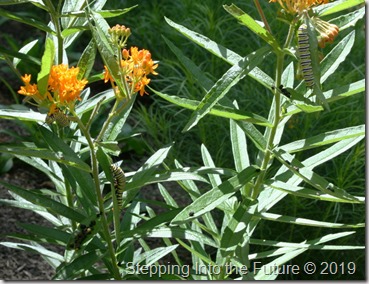Walking on the Wild Side
11August 2, 2019 by Jean
A rural retirement is not for everyone. My house at the end of a dirt road in the Maine woods is not that far off the beaten track, only one mile from a main road; even so, rural life comes with inconveniences. Probably the biggest inconvenience for an older person is the necessity of driving. Even a trip to the supermarket is a 15-mile round trip, and there is no public transportation. During our fairly long winter, the need to drive on country roads is a particular challenge. Dependence on a not-always-reliable electrical grid is another inconvenience. Power outages are not rare here; and when the power goes out, we lose not only lights, heat and internet access, but also access to running water from our private wells. (I think I am now the only homeowner on my rural dirt road who has not invested in a propane-powered generator that comes on automatically when the power goes out.)
So what are the compensations that make these inconveniences worthwhile? For me, it is the ability to live a life close to nature. I spend a lot of time looking out the windows at the plant and animal life outside. In the winter months, the long hours of dark away from city lights make for excellent star-gazing. In the warm-weather months, I keep windows open most of the time and enjoy the music of birdsong. I spend time outdoors just about every day: in the garden, going for a walk, eating meals on the porch or deck, stacking or bringing in firewood, or shoveling snow.
At this time of year, I go for a walk first thing when I get up, enjoying the calm of the early morning world before it gets too warm. My most frequent walk takes me a mile along roads in my neighborhood to the Little Androscoggin River. I cross the bridge over the river, looking upstream to see how high or low the river is running and looking for wildlife (a great blue heron can often be seen fishing here). On the other side of the bridge, I turn around and head back, this time crossing on the downstream side and checking out the views and wildlife in that direction. Recently, I have been treated to the entrancing sight of a bald eagle perched on a tree that hangs out over the river. It’s not there every day, but often enough that my steps quicken and I feel a rush of anticipation as I approach the bridge.
Sometimes my wildlife sightings are closer to home, as on a recent Saturday morning when I looked out my bedroom window to see two fox kits exploring the front garden. I watched them for a few minutes, until one looked up and saw me in the window and they ran off.
My other wildlife treat this summer has been on a much smaller scale. Last year, I had a monarch butterfly in my garden for the first time in more than five years. It was attracted to the wild milkweed that I have been allowing to grow here and there, and it deposited some eggs which turned into monarch caterpillars feeding on the milkweed. This year, the monarchs are a bigger presence. The butterfly weed (another species of milkweed) that I planted in the front garden last year has been an even bigger attraction than the common milkweed. One day, I counted at least ten caterpillars of varying sizes feeding on the butterfly weed, and I also saw what looked like a newly emerged butterfly. When the number of visible caterpillars diminished, I assumed they had found hidden places to pupate.  This week, I saw two butterflies, presumably one male and one female, doing their spiral flight dance, which seems to promise more eggs and caterpillars to come. And then one evening, as I was strolling through the garden after dinner, I spotted two jewel-like jade-green monarch chrysalises along the side of the driveway, one hanging from a blade of grass and the other from some vetch. I am keeping an eye on these, hoping to see new monarch butterflies emerge from them in the days to come.
This week, I saw two butterflies, presumably one male and one female, doing their spiral flight dance, which seems to promise more eggs and caterpillars to come. And then one evening, as I was strolling through the garden after dinner, I spotted two jewel-like jade-green monarch chrysalises along the side of the driveway, one hanging from a blade of grass and the other from some vetch. I am keeping an eye on these, hoping to see new monarch butterflies emerge from them in the days to come. 
Observing all of this requires me to slow down, listen, look closely, and really live in the moment. And this is what I value most about a retirement lived close to the wild.




Your world is wonderful. To be able to see wildlife and be out in nature every day would make anyone find a place of peace within.
Planting to create a better invironment for butterflies is being pushed here, too. You’re proving it does pay off.
Oh, and I’m in the city and my round-trips to the grocery store are 12 miles and we have no public transportation in the suburb where I’m at. So by comparison you’re not trading off much by living in a rural area. We did just get grocery delivery last year but one of my great-niece’s lives so far out in the boondocks there isn’t a store around for 30 miles and she can get grocery delivery there from the same grocery chain that services my area. Those delivery people are like Uber drivers, someone in her area saw a need and signed up to deliver in the boonies.
Jean, I feel as though I am living a version of “forest bathing,” getting into a calming, meditative state through connection with nature.
I don’t think any of the grocery chains in my area do delivery. One does offer a shopping service where you submit your list and then drive through and pick up your order. A couple of friends of mine with health problems have found this service very helpful.
Now that we use rainwater when we can in winter, if we also have loadshedding … no water. But we are planning photovoltaic panels on the roof next.
How exciting to see a bald eagle on your regular morning walk!
Diana, I’m so impressed with all the steps you and Jurg have taken to shrink your carbon footprint. Photovoltaic panels on the roof is a dream of mine.
The bald eagle seems to have moved on to other fishing grounds, but it was such a treat while it was hanging out in my neighborhood.
Jean,
I too have finally have the pleasure of seeing Monarch caterpillars on my milkweeds. I planted common milkweed 3 years ago from “The Native Seed Project” here in Maine, and some butterfly
weed last year from the Audubon’s native plant sale. Found caterpillars (5 total) on both. Last year all I found was some Tussock moth caterpillars. I’ve lived here a while and rarely if ever saw Monarchs before on my property. Plenty of Swallowtail butterflies though. I am glad that I’m able to do my small part in saving the Monarchs.
Gary, The first year I let the milkweed grow up near my back door, I was thrilled to find it covered with caterpillars, thinking they were monarchs. Of course, they turned out to be milkweed tussock moths. This year, the monarchs seem to be out-competing the tussock moths for Asclepias real estate. This morning, I counted more than a dozen monarch caterpillars, eight feeding on the common milkweed and eight more on the butterfly weed; and this evening, I saw a monarch butterfly depositing still more eggs on the butterfly weed. A few years ago, I thought I would never see monarchs again in my garden, and this turn around is such a thrill.
Yes it is!
How wonderful that you have been able to attract monarch butterflies to your yard!
Jude
Jude, It is such a treat. I have been compulsively counting monarch caterpillars feeding on my plants (more than a dozen this morning).
It’s me checking in from far away. A few years back (maybe 20) the state sprayed for Glassy Winged Sharpshooters, because they posed a danger to the local wine industry. All the grapes died anyway, and it was years before we saw butterflies of any stripe. When I finally saw cabbage butterflies flitting about, I was delighted they were back. This property has been an organic farm since 1928. That may have helped us, because within a year or two we had many and diverse butterflies again. Our number one guests are hair streaks, number two is probably monarchs. We are again in the throes of a disease invasion. This time it’s citrus regreen disease. California it seems has learned something in the intervening years. They are not carpet bombing this time. The agricultural inspectors come and inspect every property, then tell you whether or not you have to spray or destroy your citrus trees. And organic property is usually exempt.
LOL, Wendy, we’ve reached the stage of life where twenty years feels like “a few years back.” I think (hope) many people have finally gotten the message that throwing chemicals at an insect or disease problem usually creates more problems than it solves. There’s been more emphasis here on organic agriculture and horticulture and on biological controls. (I now check my Japanese beetles for tachinid fly larvae before I pick them off and drop them in my “beetle soup” container of soapy water.) The Maine Organic Farmers and Gardeners Association provides outstanding leadership and also support for young farmers joining Maine’s small but growing family farm agricultural sector. I was encouraged to learn this year that the Land Institute in Kansas is working on the development of perennial grains as a more sustainable form of agriculture.